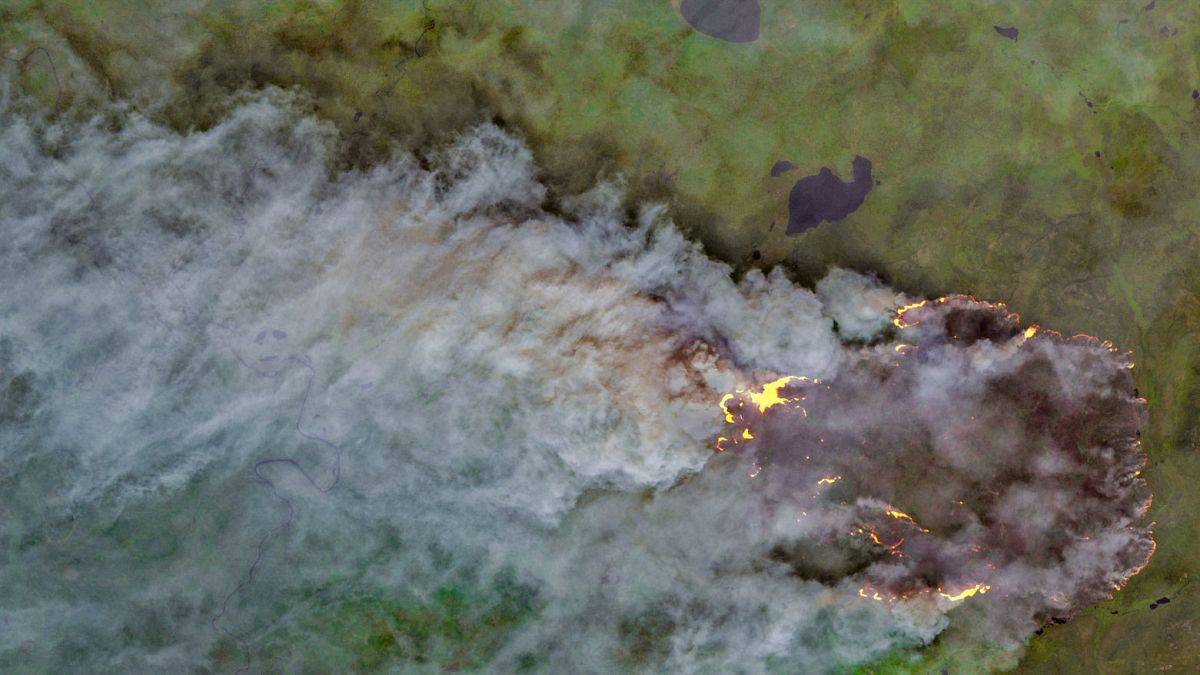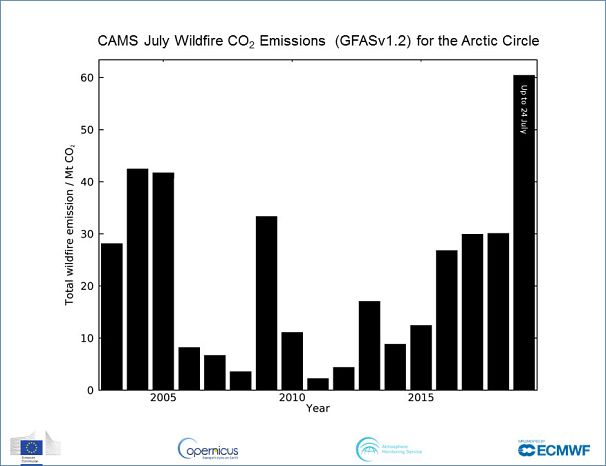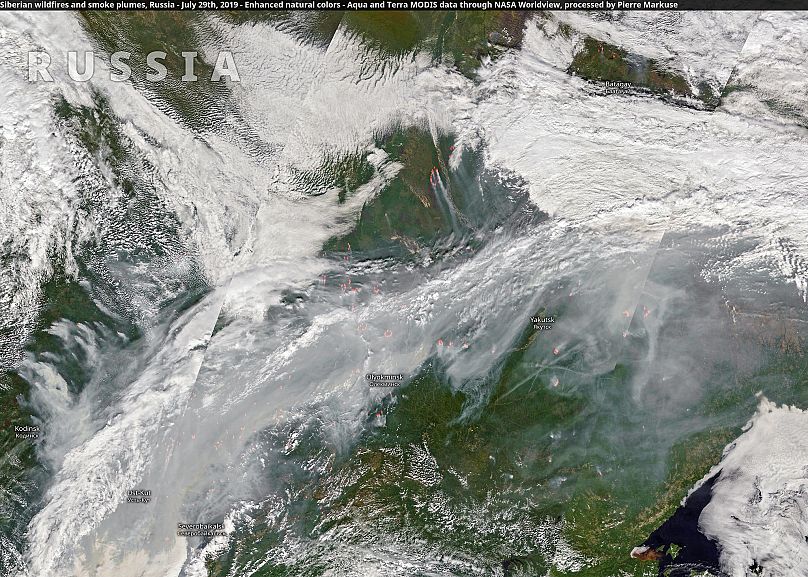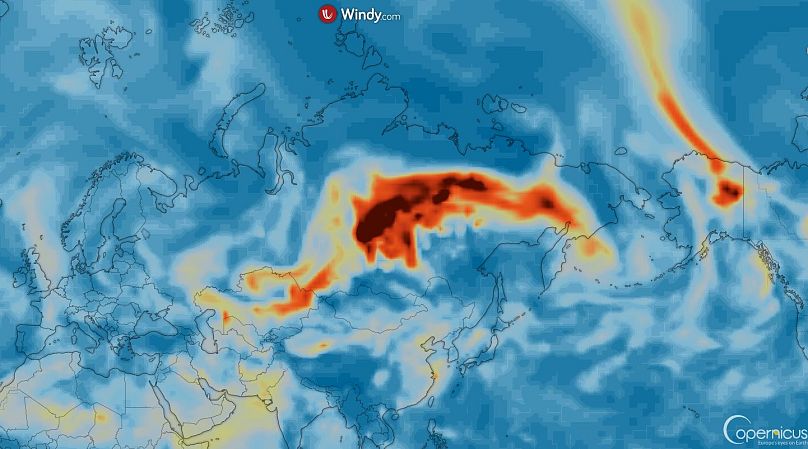While most of Europe is focussing on this week's record-breaking heatwave, maybe we should have a closer look at what is happening in the Arctic Circle.
While most of Europe is focussing on this week's record-breaking heatwave, others are making worried glances at what is happening in the Arctic Circle.
More than 100 "intense and long-lived wildfires" have been pumping carbon dioxide into the sky over the last eight weeks, according to the Copernicus Atmosphere Monitoring Service (CAMS).
The total carbon dioxide emissions of the fires exceed the total yearly emissions of countries like Bulgaria, Hungary or Sweden, according to Mark Parrington, a senior scientist at the monitoring service.
'Staggering'
The emissions also exceeded the levels than in any previous year over the past 17 years.
"Although wildfires are common in the northern hemisphere between May and October, the latitude and intensity of these fires, as well as the length of time that they have been burning for, has been particularly unusual," said CAMS in a statement.
In one Siberian district, satellite imagery expert Pierre Markuse showed one fire had an area of 550 square kilometres. The situation was still ongoing on Monday July 29. And temperatures in the region will remain unusually low at least for the week.
Atmospheric scientist Dr Santiago Gasso wrote that fires in Siberia had created "a smoke lid" over 4.5 million square kilometres.
"That is staggering," he wrote.
Local authorities say they can only extinguish fires when there is a threat to human settlements or economic facilities due to the extent of the region and the lack of means.
CAMS monitoring service showed heavy smoke from Arctic wildfires across Eurasia and North America.
Scientists say that satellite data of wildfires and greenhouse gas emissions is available for the last 17 years.
Although there has been an increase of wildfires in the region over the past three or four years, this year has been exceptional.
“It is unusual to see fires of this scale and duration at such high latitudes in June,” said CAMS wildfire expert Mark Parrington last month. “But temperatures in the Arctic have been increasing at a much faster rate than the global average, and warmer conditions encourage fires to grow and persist once they have been ignited.”
He said next year would give a clearer picture on whether it is a continuing trend.
Parrington said while CO2 is one of many pollutants in fires it is particularly striking because CO2 emissions can be compared to fossil fuel emissions from countries. The emissions of the Arctic Wildfires only in July, equal the total yearly emissions of Countries like Bulgaria or Sweden, according to the scientist.
Russians have taken to social media to post using the hashtag #ПОТУШИТЕПОЖАРЫСИБИРИ (stop the wildfires in Siberia) and #SaveSiberianForests.
It started mainly with citizens from the region complaining about the smoke from wildfires in the area, but the cause became more popular with several celebrities joining in to ask for a rapid response from the Federal Government.
A petition on Change.org had over 600.000 signatures at the time of updating. Greenpeace Russia also created a petition with 100.000 signatures so far.
The Arctic and high mountain environments are suffering much more than the rest of the planet from global warming. Think of the Arctic as a "natural freezer" that cools and helps moderate global climate. If the Arctic ice melts, like the land-based ice in Greenland, it causes sea levels to rise.
While ice is melting at a record pace, science is still not sure what effects it will have on the weather or, in the long term, on climate change.
Extreme weather conditions and climate change
What scientists are detecting is that climate change is changing traditional patterns. The jet stream has weakened in recent years, creating new, and often extreme, weather situations. Jet streams are relatively narrow bands of strong wind in the upper levels of the atmosphere.
What is clear is that the greenhouse gases emitted by the Arctic fires will not help to improve the situation.
Warming effects are especially intense in the North Pole. Scientists admit they don't know the exact consequences for the weather of the rapid melt in the Arctic but the Poles act as the Earth's thermostat but say that the human-induced climate change could be the reason.
José Miguel Viñas, a meteorologist from Tiempo.com recently explained to Euronews that the reduction in the temperature difference in the polar and tropical regions of the northern hemisphere is causing changes in atmospheric circulation. He said the so-called QRA (quasi-resonant amplification) "explains why heatwaves of frequency and intensity are increasing here in Europe and in other parts of the world at temperate latitudes, interspersed by periods when cold air is leaking in, That causes particularly intense storms. In short, it seems clear that weather is becoming more extreme and this can be justified, at least in part, by the aforementioned climate change and that circumstance that I have mentioned."
Climate Scientist Michael Mann who is a professor and director of the Penn State Earth System Science Center showed in a 2017 study that changes in temperature near the poles could be influencing planetary waves and therefore, air currents.
"This pattern is favoured by human-caused climate change, giving us more frequent, persistent weather extremes, like we are seeing right now," Mann told Euronews.
"Extreme warmth in the Arctic and the loss of Arctic sea ice due to human-caused climate change favours this jet stream pattern and indeed we are right now witnessing record Arctic warmth and record-low sea ice for so early in the season."
The World Meteorological Organisation said on Friday the heatwave Europeans experienced this past week will now move north towards Greenland. "This will result in high temperatures and consequently enhanced melting of the Greenland ice sheet,” said Clare Nullis, spokeswoman for the U.N. World Meteorological Organization. “In July alone, it lost 160 billion tonnes of ice through surface melting. That’s roughly the equivalent of 64 million Olympic-sized swimming pools. Just in July. Just surface melt - it’s not including ocean melt as well.” she added, citing data from Denmark’s Polar Portal.
This is also expected to impact Arctic sea ice.
“Such intense and widespread heatwaves carry the signature of man-made climate change,” said Johannes Cullmann, Director of WMO’s Climate and Water Department.



